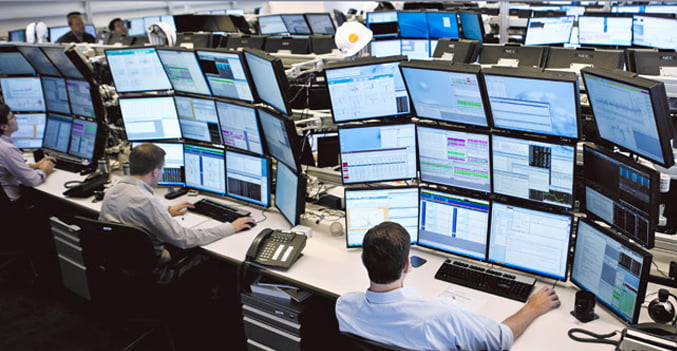Before you got into stock trading, I’m guessing you didn’t think too much about the mechanics of how stocks are bought and sold.
And if you did, chances are you stopped short in the face of the complexity of the situation – refusing to contemplate the intricacies of what happens behind the scenes every time you hit the “Buy” or “Sell” button on your brokerage platform.
Well, let’s get one thing straight right now… if you want to be as successful as possible at this stock trading gig, you’ve got to know the ins and outs of how this whole system works. And the good news is, it doesn’t have to be as complicated as it may seem.
Today, I’m throwing back the curtain on one of trading’s most mysterious players – the market maker. I want you to get to know who market makers are and how they work, as their presence and the functions they perform have a direct impact on how your future trades are carried out.
How Trades are Executed
One of the first things you need to know is that trades can be executed in a number of different ways.
Say you want to buy 1,000 shares of Company A. Another trader – Trader B – located somewhere in the world, wants to sell 1,000 shares of Company A. Your order is filled from his shares by your brokerage firm, resulting in a neat and clean transaction for both parties.
But now, let’s say that there is no Trader B. You still want to buy those 1,000 shares, so do you have to sit around and wait for somebody new to place a sell order?
Not necessarily.
This is where a group of traders known as “market makers” come into play.
The Role of the Market Maker
A market maker (MM) is a trader whose job is to provide liquidity and set buy and sell prices based on stocks that they either hold in their inventory or that they “make a market in.”
Market makers work with firms that are registered with FINRA, and they typically receive orders electronically (or over the phone for the dinosaurs).
On average, you’ll see between 4-40 market makers for a given stock, depending on its average daily trading volume. MM’s set their own buy and sell prices, but once these prices are set, they’re typically obligated to buy or sell at least 1,000 shares at their advertised price (though these minimum quote requirements can change based on price level).
Combined with restrictions that require market makers to offer customers the best buy and sell prices, this prevents price gouging and excess volatility by maintaining a fair and reasonable two-sided market.
The Concept of “Order Flow”
This may surprise you but most brokerage firms – traditional and online – don’t actually buy or sell your stock themselves.
To keep costs down, a lot of online brokers will “sell” their orders (essentially, their clients’ buy and sell orders) to market makers. Hence, the MM is getting the brokers’ “order flow”.
Essentially, this market maker pays your brokerage firm to get your order. This is known as payment for order flow.
The brokerages sometimes even make deals to send the bulk of their order flow to a specific MM. The market maker NITE mastered the order flow practice in the early 2000’s (when online & electronic trading began to explode) to become the most important MM on the block.
So why does the MM buy orders from the broker?
The answer: So that they can get a boatload of retail orders (including yours and mine) and make money off of the spreads. You see, market makers see it as worthwhile to pay your online broker to get your stock orders because they believe that profiting from the spread will far exceed their payment for order flow.
At the very least, you should be able to know who your broker is selling its orders to, right? Well you can. They must inform you on your trade slips and in the agreement you sign when opening your account. So take a minute to find out this interesting detail, it might make you say hmmmm or aha!
How Do Market Makers Make Money?
Understanding the role market makers play is best achieved by looking at an example of how they actually make money. Essentially, as mentioned above, the market maker hopes to make money on what’s called the “spread” – which is the difference between the Bid and the Ask (the word “Offer” is often used instead of Ask – hence the Bid and Offer).
So, let’s say you’re ready to buy a stock…
The stock is quoted with a $25 bid and $26 ask.
You want to buy the 500 shares at $26, where it’s being “offered” (Ask).
If there is no actual seller to directly match up with your buy order then the market maker will sell you 500 shares at $26, whether he owns the stock in his inventory or not.
Now, if he doesn’t own the stock in his inventory, he’ll have to go back and buy it in the market in order to cover the shares he sold you. This is called being short the stock to retail (where you are the retail buyer).
He’ll put in a bid at $25.01 and see if someone hits it or sells him stock at that level.
When someone does, he’ll make 99 cents on the stock he just sold you at $26, since he’s buying back at $25.01.
Basically, he makes $0.99 x 500 shares, for a total profit of $495.
The reverse applies if you were looking to sell 500 shares at $25.
In this case, the market maker buys 500 shares from you at $25, then turns around and tries to sell it on the Ask at $26, or even lower – say $25.99 – so he’ll be the “Best Ask.”
When the next buy order comes in at $25.99, he’ll make the same $495 on that trade.
That may sound like too small a profit to be worth all of that trouble, but remember that a market maker might carry out this kind of transaction a few thousand times a day.
In that light, it’s easy to see why these jobs are some of the most coveted at small and large firms. In fact, at big firms like Knight Capital Markets (NITE) that compete for order flow from the big brokerage houses, top MM traders can earn as much as seven figures a month!
Sounds Like A Great Job, Huh?
At this point, it probably sounds pretty tempting to set your sights on a market maker position, but remember that it’s not even close to as easy as it sounds. The market maker is at risk all the time. He could fill an order, only to have the price move against him – wiping out his profits entirely. If that happens often enough, he’ll lose his seat at the firm.
On the flip side, if he attempts to minimize this risk and “play it safe”, he’ll most likely be penalized in a different way. If the firm sees that a market maker isn’t willing to take on risk in a particular stock, the stock will be taken away from him and given to someone else on the floor who’s prepared to be more aggressive.
Ultimately, market making requires managing an extraordinary number of variables all at once. Market makers maintain a “list” of stocks they provide liquidity in, which could include 300 or more different ticker symbols (companies). Not only do they have to know where their Bids and Asks are at all times, they have to know whether they’re long or short, what size position they hold and how these positions affect their net capital.
Imagine having to do all that for 300+ stocks at the same time every second of the trading day. My head spins just thinking about it!
The Take-away
Market making firms are a crucial piece of the trading puzzle. They often get a bad rap (sometimes deservedly) but without them we’d be sitting around and waiting…and waiting…and waiting for our orders to get filled.
Don’t obsess over figuring out what everything they do means. Learn to recognize the activities of market makers and the impact they have on the market in general.
Market makers are a tricky concept, so it’s common to have questions about how they work and how they make money.
In a future post I’ll go into some greater detail of specific things you can look for in the Level 2 window (MM order book) that can “tip you off” to the potential direction the stock may move in.
If there’s anything else you’d like to know about these important market figures, leave a question below in the comments section for more information!










